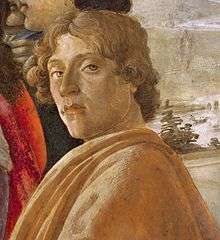Mars and Venus (Botticelli)

Mars and Venus is a c. 1483 painting by the Italian Renaissance painter Sandro Botticelli. It shows the Roman gods Venus and Mars in an allegory of beauty and valour. The youthful and voluptuous couple recline in a forest setting, surrounded by playful satyrs. The painting is typically held as an ideal of sensuous love, of pleasure and play.
In the painting Venus watches Mars sleep while two infant satyrs play, carrying his helmet and lance as another rests inside his breastplate under his arm. A fourth blows a small conch shell in his ear in an effort to wake him. Although the work draws from classical sources, perhaps in particular the description by Lucian of a lost painting of the marriage of Alexander the Great and Roxana, it diverges from these in important aspects, and is a product of early Renaissance Neoplatonist thinking. The scene is set in a haunted forest, and the sense of perspective and horizon extremely tight and compact. The sea from which Venus emerged can be seen in the distant background. In the foreground, a swarm of wasps hovers around Mars' head, possibly as a symbol that love is often accompanied by pain.[1]
Another possible explanation is that the wasps represent the Vespucci family that may have commissioned the painting; the symbol of the Vespucci house is the wasp. The painting is thought originally to have been the back of a lettuccio, a wooden sofa, or a similar piece of furniture.[2]
Sources
The image may be based on the Stanze of Poliziano. Stanze 122 describes how the hero found Venus "seated on the edge of her couch, just then released from the embrace of Mars, who lay on his back in her lap, still feeding his eyes on her face". Poliziano was one of the humanist scholars in the court of Lorenzo de' Medici, and in his stanze he alludes to Giuliano di Piero de' Medici's prowess in a jousting tournament his older brother Lorenzo had organized to celebrate a treaty with Venice. The ultimate source for Politian's poem is Lucretius I.32-34.
Giuliano di Piero de' Medici is most likely the athletic model for the war god who slumbers next to the goddess in this work. However, the description, with Mars in Venus' lap, gazing up at her, is a poor fit to the painting. Venus may have been Simonetta Vespucci, a great beauty of the time, married to the cousin of Amerigo Vespucci. Botticelli, who portrayed her many times after her death, asked to be buried, as she had been, in the Church of Ognissanti in Florence.
Promenance
Although today Botticelli is the most celebrated Florentine painter of second half of the 15th century, he was only rediscovered in the late 19th century when his emphasis on line and contour chimed with the contemporary sensibility. Between 1857 and 1878, the National Gallery, London, acquired five of his works, including Venus and Mars.[1]
See also
Notes
References
- Fowler, H. W. and F. G. (eds.) The Works of Lucian of Samosata, Oxford, 1905.
- Ficino, Marsilio, Commentary on the Symposium: De Amore, from Oration V, chapter 8
- Potterton, Homan. The National Gallery. London: Thames and Hudson, 1977
- Quint, David. (tr). (1979) The Stanze of Angelo Poliziano. Amherst: University of Massachusetts Press ISBN 0-87023-145-6
- Righini, Mariella (1999) Florentine. Paris: Flammarion
